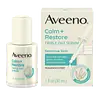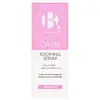What's inside
What's inside
 Key Ingredients
Key Ingredients

 Benefits
Benefits

 Concerns
Concerns

No concerns
 Ingredients Side-by-side
Ingredients Side-by-side

Water
Skin ConditioningGlycerin
HumectantButylene Glycol
HumectantBis-PEG-18 Methyl Ether Dimethyl Silane
EmollientIsodecyl Neopentanoate
EmollientPentaerythrityl Tetraethylhexanoate
EmollientEthylhexylglycerin
Skin ConditioningPhenoxyethanol
PreservativeAmmonium Acryloyldimethyltaurate/Vp Copolymer
Chlorphenesin
AntimicrobialDimethicone
EmollientSuccinoglycan
Skin ConditioningChrysanthemum Parthenium Flower/Leaf/Stem Juice
AntioxidantAvena Sativa Kernel Flour
AbrasiveAvena Sativa Kernel Oil
Skin ConditioningAcrylates/C10-30 Alkyl Acrylate Crosspolymer
Emulsion StabilisingDimethiconol
EmollientSodium Hydroxide
BufferingAvena Sativa Kernel Extract
AbrasiveWater, Glycerin, Butylene Glycol, Bis-PEG-18 Methyl Ether Dimethyl Silane, Isodecyl Neopentanoate, Pentaerythrityl Tetraethylhexanoate, Ethylhexylglycerin, Phenoxyethanol, Ammonium Acryloyldimethyltaurate/Vp Copolymer, Chlorphenesin, Dimethicone, Succinoglycan, Chrysanthemum Parthenium Flower/Leaf/Stem Juice, Avena Sativa Kernel Flour, Avena Sativa Kernel Oil, Acrylates/C10-30 Alkyl Acrylate Crosspolymer, Dimethiconol, Sodium Hydroxide, Avena Sativa Kernel Extract
Water
Skin ConditioningGlycerin
HumectantPropanediol
SolventNiacinamide
SmoothingCoco-Caprylate/Caprate
EmollientCaprylic/Capric Triglyceride
MaskingPropylene Glycol
HumectantAvena Sativa Leaf/Stalk Extract
Skin ConditioningPhenoxyethanol
PreservativeAloe Barbadensis Leaf Juice
Skin ConditioningHydroxyethyl Acrylate/Sodium Acryloyldimethyl Taurate Copolymer
Emulsion StabilisingAcrylates/C10-30 Alkyl Acrylate Crosspolymer
Emulsion StabilisingChlorphenesin
AntimicrobialBiosaccharide Gum-2
Skin ConditioningSodium Hydroxide
BufferingTremella Fuciformis Sporocarp Extract
AntioxidantXanthan Gum
EmulsifyingSaccharomyces Ferment Filtrate
HumectantCitric Acid
BufferingTrisodium Ethylenediamine Disuccinate
Polysorbate 60
EmulsifyingSorbitan Isostearate
EmulsifyingSodium Benzoate
MaskingPotassium Sorbate
PreservativeTocopherol
AntioxidantWater, Glycerin, Propanediol, Niacinamide, Coco-Caprylate/Caprate, Caprylic/Capric Triglyceride, Propylene Glycol, Avena Sativa Leaf/Stalk Extract, Phenoxyethanol, Aloe Barbadensis Leaf Juice, Hydroxyethyl Acrylate/Sodium Acryloyldimethyl Taurate Copolymer, Acrylates/C10-30 Alkyl Acrylate Crosspolymer, Chlorphenesin, Biosaccharide Gum-2, Sodium Hydroxide, Tremella Fuciformis Sporocarp Extract, Xanthan Gum, Saccharomyces Ferment Filtrate, Citric Acid, Trisodium Ethylenediamine Disuccinate, Polysorbate 60, Sorbitan Isostearate, Sodium Benzoate, Potassium Sorbate, Tocopherol
 Reviews
Reviews

Ingredients Explained
These ingredients are found in both products.
Ingredients higher up in an ingredient list are typically present in a larger amount.
Acrylates/C10-30 Alkyl Acrylate Crosspolymer is a synthetic polymer. It is used to thicken and improve the texture of products. Due to its properties, it can prevent water and oil ingredients from separating.
Chlorphenesin is a synthetic preservative. It helps protect a product against bacteria in order to extend shelf life. In most cases, Chlorphenesin is paired with other preservatives such as phenoxyethanol and caprylyl glycol.
Chlorphenesin is a biocide. This means it is able to help fight the microorganisms on our skin. It is also able to fight odor-releasing bacteria.
Chlorphenesin is soluble in both water and glycerin.
Studies show Chlorphenesin is easily absorbed by our skin. You should speak with a skincare professional if you have concerns about using Chlorphenesin.
Learn more about ChlorphenesinGlycerin is already naturally found in your skin. It helps moisturize and protect your skin.
A study from 2016 found glycerin to be more effective as a humectant than AHAs and hyaluronic acid.
As a humectant, it helps the skin stay hydrated by pulling moisture to your skin. The low molecular weight of glycerin allows it to pull moisture into the deeper layers of your skin.
Hydrated skin improves your skin barrier; Your skin barrier helps protect against irritants and bacteria.
Glycerin has also been found to have antimicrobial and antiviral properties. Due to these properties, glycerin is often used in wound and burn treatments.
In cosmetics, glycerin is usually derived from plants such as soybean or palm. However, it can also be sourced from animals, such as tallow or animal fat.
This ingredient is organic, colorless, odorless, and non-toxic.
Glycerin is the name for this ingredient in American English. British English uses Glycerol/Glycerine.
Learn more about GlycerinPhenoxyethanol is a preservative that has germicide, antimicrobial, and aromatic properties. Studies show that phenoxyethanol can prevent microbial growth. By itself, it has a scent that is similar to that of a rose.
It's often used in formulations along with Caprylyl Glycol to preserve the shelf life of products.
Sodium Hydroxide is also known as lye or caustic soda. It is used to adjust the pH of products; many ingredients require a specific pH to be effective.
In small amounts, sodium hydroxide is considered safe to use. However, large amounts may cause chemical burns due to its high alkaline.
Your skin has a natural pH and acid mantle. This acid mantle helps prevent harmful bacteria from breaking through. The acid mantle also helps keep your skin hydrated.
"Alkaline" refers to a high pH level. A low pH level would be considered acidic.
Learn more about Sodium HydroxideWater. It's the most common cosmetic ingredient of all. You'll usually see it at the top of ingredient lists, meaning that it makes up the largest part of the product.
So why is it so popular? Water most often acts as a solvent - this means that it helps dissolve other ingredients into the formulation.
You'll also recognize water as that liquid we all need to stay alive. If you see this, drink a glass of water. Stay hydrated!
Learn more about Water